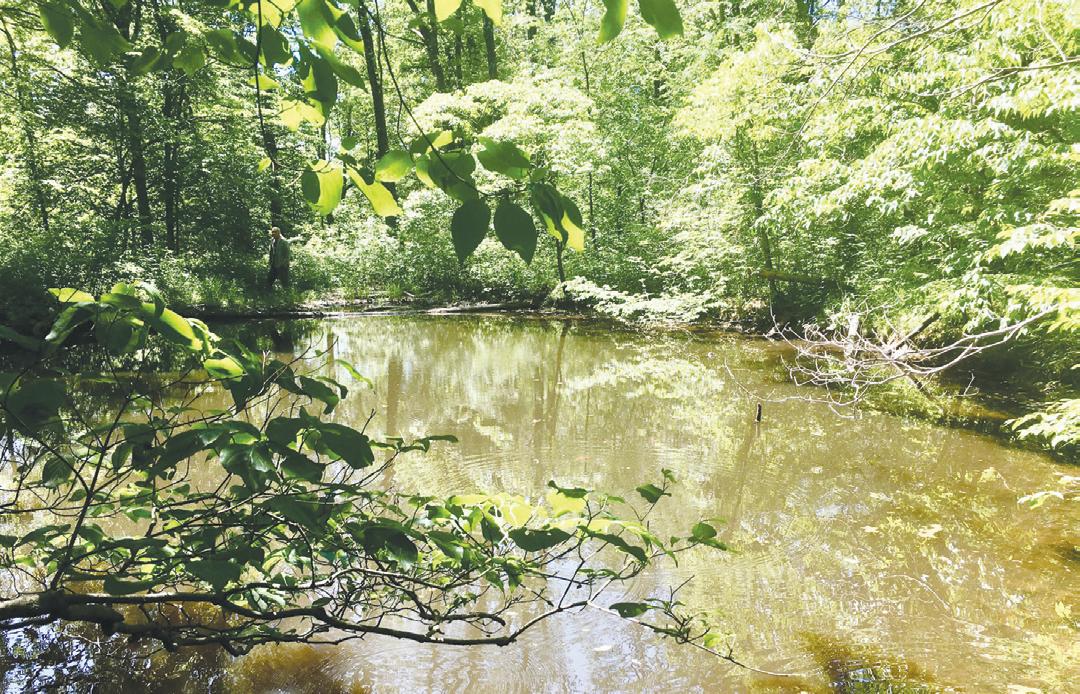
4 minute read
FIELD NOTES: Backcountry
~by Jim Eagleman
Visions of lush ravines, ridgetop trees, and pristine lakes may come to mind when someone mentions a visit to Brown County— or busy sidewalks, traffic lines, and road repairs could also register.
This county’s beauty and reputation as an Indiana getaway is enjoyed mainly by motorists. I’ll include mountain bikers, horseback riders, kayakers, canoeists, backpackers, nature photographers, fishermen, and mushroom hunters, who all arrive by vehicle.
You can drive many hills and see from the windshield a vast unexplored and rugged land, but until the boot tread hits the trail, you will miss the experience of seeing it up close and personal.
I realize not everyone comes to hike. Nashville and surrounding towns with many shops, restaurants, wineries, and breweries rate high with return visitors. Music venues, special events, and holiday celebrations entice visitors. We welcome our guests with our “open for business” hospitality sign all year.
I used the word “backcountry” to describe an experience for park visitors who wanted a little more adventure. “Bushwacking through dense vegetation with scars and blisters came to mind,” said a friend, so I dispensed with the term in talks. But I continued to encourage the exploration of the little-used trails—an old logging road or deer trail that the park and state forest has plenty of. Backcountry conjures up for me any place beyond a familiar road or trail that can be explored—remote and uncharted, the boondocks, the boonies, the outback.
Years ago, when I started with the DNR at Brown County State Park, my first impression of its sixteen thousand acres was overwhelming. Botanizing and birding, learning new trees, the geologic story, gave me goosebumps. I was giddy to think about working here.
On days off with friends, we hiked park trails and explored buildings that would later be used for programs and interpretive hikes. We visited landmarks like Deserter’s Cave, Deer Rock, and the CCC stone quarry. Old homesteads with gravestones and a tall cedar hinted of past days; remnant daffodil plantings still existed near a garden plot. And with nearly every excursion, I came upon a small pond.
Did the settlers make these ponds? Were they water sources? Or were they constructed in more recent years, maybe for recreational fishing? I read through the park’s history files and visited local libraries in order to find some answers.
While working at Turkey Run State Park, I enrolled at Depauw University for a Master’s degree in botany—a favorite discipline that would help with my work. When we moved to Brown County, I continued to take classes on my days off, and discovered more information about the park’s ponds.
The ponds were installed by the DNR’s Division of Fish and Game (now the Division of Fish and Wildlife) as a source of water for woodland species. Next to the pond, a clearing was created for a food plot planted in millet, milo, sorghum, and sunflowers. As late as the 1960s, Brown County State Park was one of many state and federal sites in southern Indiana for this Woodland Game Project, later called the Forest Wildlife Project.
I wanted to learn more about these secluded and nearly forgotten ponds, particularly since in addition to providing water, they were also breeding sites for frogs, toads, turtles, and salamanders. What kind of herptile production were the ponds experiencing? Was there any maintenance required to keep them viable, and how many were there on park property?
At his retirement, I interviewed Maury Reeves, one of the biologists who installed the ponds in the early 60s. He told me once a bulldozer operator and laborer found a suitable site, they dug it out, then moved on to another site the next day. One hundred ponds were installed on park property over three years. They were usually 50-60 feet in diameter and approximately six feet deep in the center. Dirt was pushed up creating an earthen dam and trees were stockpiled off to the side or used to reinforce the circular dam. The pond site was to be installed at the end of a long ridge before the land dropped off, with a site for the food plot nearby. Rainwater usually filled the pond within a year.
One summer, utilizing volunteer help, we compiled GPS coordinates of as many park ponds as possible. Many are still holding water. A few suffer from cattail encroachment and some show signs of horse impact, since they are close to backcountry horse trails where riders give horses a drink. A grad student study over three years monitored the production of aquatic species and was shared with other DNR managers whose properties also have ponds. The ponds are what I call “backcountry jewels” since they are rare, have high value to wildlife, and can require some time to discover.
Brown County backcountry is daunting, extremely rugged, and defined by deep ravines and narrow ridges that look very similar. Venturing out into backcountry is a serious endeavor and shouldn’t be taken lightly. Research and preparation are recommended. Phone apps can now pinpoint your travel, show you a route in and out, and replace the trusty topo map. “Hike with a Friend” is still the backcountry hiker’s mantra. Thankful that these Brown County jewels exist, I’ll eagerly plan my backcountry hikes with the hopes of finding another wildlife pond.







